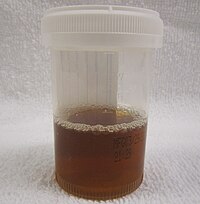
Photo from wikipedia
PurposeCrush syndrome (CS), a serious medical condition characterised by damage to the muscle cells due to pressure, is associated with high mortality, even when patients receive fluid therapy during transit… Click to show full abstract
PurposeCrush syndrome (CS), a serious medical condition characterised by damage to the muscle cells due to pressure, is associated with high mortality, even when patients receive fluid therapy during transit to the hospital or admission to the hospital. There is no standard triage approach for earthquake victims with crush injuries due to the scarcity of epidemiologic and quantitative data. We examined whether mortality can be predicted based on the severity of skin damage so that assess the severity and prognosis in crush syndrome by assessment of skin damage in hairless rats because we have previously observed that CS results in oedema and redness of the skin in rats.MethodsAnaesthetised rats were subjected to bilateral hind limb compression [1 kg (mild) and 2 kg (severe) loads] with a rubber tourniquet for 5 h. The rats were then randomly divided into three groups: sham, mild CS, and severe CS.ResultsThe mild and severe CS groups had mortality rates of 20 and 90%, respectively. The severe CS group demonstrated higher rates of hyperkalaemia, hypovolemic shock, acidosis, and inflammation. Skin damage was significantly worse in the severe CS group compared to the mild CS group. Skin damage showed good correlation with pathological severity.ConclusionsSkin damage is a valid measure of transepidermal water loss and severity of CS. We suggest that these models may be useful to professionals who are not experienced in disaster management to identify earthquake victims at high risk of severe CS.
Journal Title: European Journal of Trauma and Emergency Surgery
Year Published: 2018
Link to full text (if available)
Share on Social Media: Sign Up to like & get
recommendations!